When creating oil-based solid perfumes, you'll need protective gear, proper ventilation, and dark glass containers. Start with a 2:1:1 ratio of base, heart, and top notes, using jojoba or fractionated coconut oil as carriers. Test small batches first, keeping concentrations around 10% fragrance oil. Always use a double boiler method, add vitamin E as a natural preservative, and apply to pulse points. These essential tips just scratch the surface of perfume-making mastery.
Essential Safety Measures Before You Begin

Before diving into solid perfume creation, understanding essential safety measures is crucial for protecting yourself and your workspace.
Safety first: mastering essential precautions is vital before beginning your solid perfume journey to protect yourself and your creative space.
You'll need to wear protective gear and guarantee proper ventilation when handling concentrated ingredients.
Always dilute essential oils properly, as they can cause skin irritation in their pure form.
Keep all ingredients away from open flames since many oils are flammable.
Don't let any materials contact your mouth or eyes, and be especially careful with photosensitive oils like Bergamot if you'll be in sunlight.
When selecting carrier oils, choose skin-safe options like Jojoba or Sweet Almond.
The entire process should take about 15 minutes from start to finish, allowing you to work efficiently while maintaining safety protocols.
Store your ingredients in a cool, dry place and keep containers tightly sealed.
Remember to wash your hands thoroughly after handling materials, and never eat or smoke during preparation.
Understanding Base Notes, Middle Notes, and Top Notes
Perfume creation relies on understanding the three foundational layers of fragrance: base notes, middle notes, and top notes.
When you first apply perfume, you'll notice the top notes – light, volatile scents like citrus and fresh herbs that last 5-15 minutes. These create your first impression before smoothly shifting to the heart notes. Understanding these notes helps you find perfect fragrances.
The middle (heart) notes make up 40-80% of your fragrance, featuring floral and spicy elements like rose, jasmine, and cinnamon. They bridge the gap between top and base notes, providing depth and balance.
Finally, your base notes, comprising 10-25% of the blend, offer rich, lasting scents like cedarwood, vanilla, and musk.
For a balanced blend, use a 2:1:1 ratio of base, heart, and top notes, adjusting drop by drop to achieve your desired harmony.
Selecting the Perfect Carrier Oil Blend
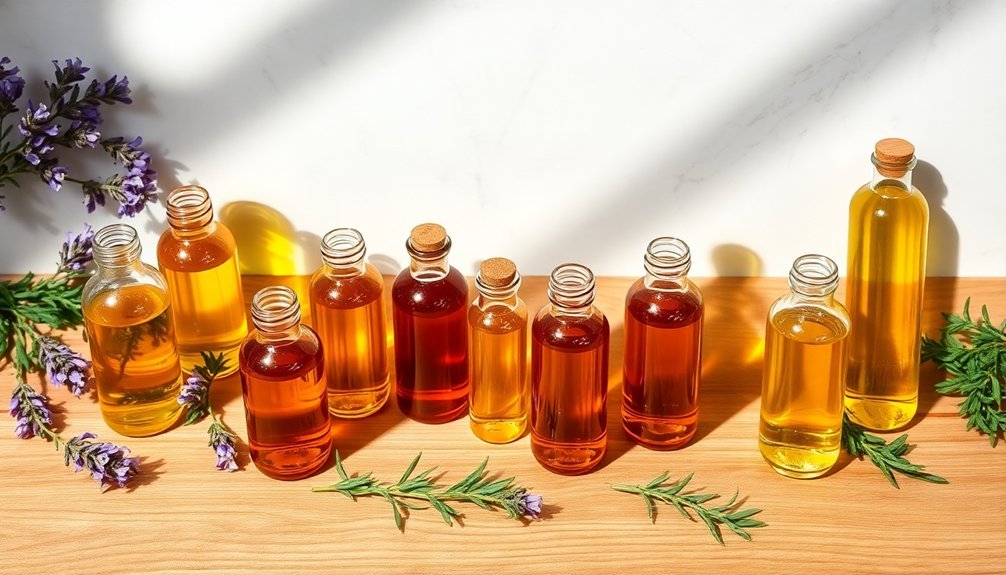
Now that you understand fragrance layering, your next step is selecting the right carrier oil blend. Your choice of carrier oils will affect both the feel and longevity of your solid perfume.
Jojoba oil stands out as a top choice due to its stability and non-greasy texture, while fractionated coconut oil provides a neutral base that won't compete with your fragrance.
Double boiler heating ensures proper blending of your carrier oils for optimal results. For the perfect carrier oil blend, consider these key factors:
- Combine jojoba with sweet almond oil for balanced moisturizing properties
- Use neutral-scented oils to preserve your fragrance profile
- Select oils with longer shelf life to prevent rancidity
- Adjust the ratio based on your desired texture when mixed with beeswax
Remember that proper storage in a cool, dark place will help maintain your perfume's quality over time.
Mastering the Double Boiler Method
Creating a successful solid perfume hinges on three essential steps, with the double boiler method being the most crucial for achieving the perfect consistency.
You'll need to set up your double boiler by filling the bottom pot with water, ensuring it doesn't touch the upper container. If you don't have a dedicated double boiler, you can use a heat-resistant bowl placed over a pot of simmering water.
Before melting your ingredients, prepare your heat-safe containers to avoid rushing with hot liquids.
Maintain low to medium heat while melting your equal parts beeswax and carrier oil mixture, stirring constantly to prevent lumps. Once fully melted, remove from heat, quickly add your essential oils, and pour into your prepared containers.
Let the mixture cool completely before capping.
Calculating Essential Oil Dilution Ratios
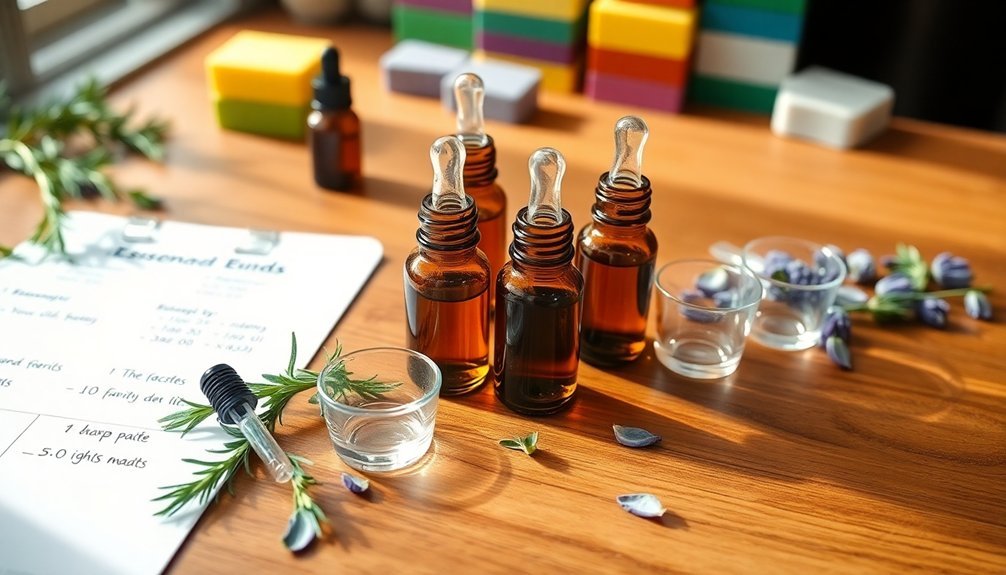
With your base mixture ready in the double boiler, precise essential oil calculations become your next focus.
For a safe and effective solid perfume, you'll want to aim for a 2-3% dilution of essential oils in your carrier base. Since solid perfumes are applied sparingly, you can work with this slightly higher concentration than typical skin applications.
- Use 20 drops per 1ml as your conversion guide
- Follow the 2:1:1 ratio (base:heart:head notes) for balanced fragrance
- Calculate your total essential oil amount first, then divide among notes
- Adjust individual oil quantities based on their specific potency
Remember that different oils have varying strengths, so you might need to tweak these ratios slightly.
When in doubt, start with less and adjust upward – you can always add more, but you can't take it out once it's mixed.
Choosing the Right Container for Your Solid Perfume
Selecting the right container proves essential for preserving your solid perfume's quality and enhancing its usability. You'll find aluminum containers offer durability at an affordable price point, while plastic options provide toughness and color retention. For a premium look, contemplate magnetic swivel or luxury metal compact cases.
| Container Type | Best For | Size Range |
|---|---|---|
| Aluminum Tins | Daily Use | 5-10g |
| Plastic Cases | Travel | 2.3-5g |
| Metal Compacts | Luxury | 5-10g |
| Eco-Friendly | Sustainability | 2.3-10g |
| Refillable | Long-term Use | 5-10g |
Choose containers that align with your intended use. If you're creating samples, opt for smaller 2.3g sizes. For regular use, standard 5-10g containers work well. Don't forget to contemplate refillable options to reduce waste and enhance customer satisfaction.
Testing and Adjusting Your Fragrance Blend
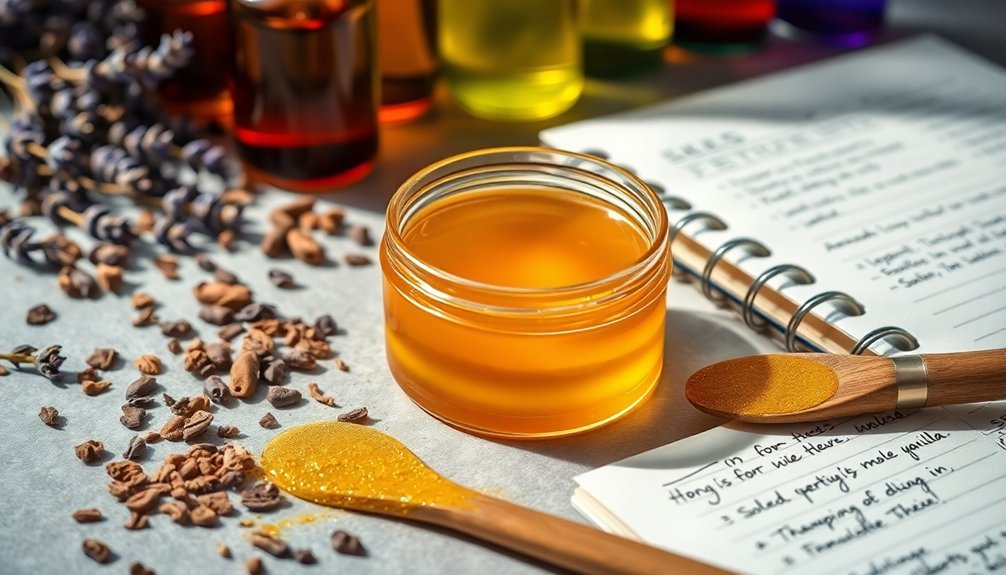
You'll need to perfect your fragrance ratios through careful testing before committing your blend to a solid form.
Test your fragrance combinations in small batches using carrier oils to evaluate how the scents interact and evolve over time.
Start with lower concentrations around 10% fragrance oil and adjust upward based on your testing results, always keeping track of your proportions for consistency.
Perfume Ratio Mastery
Creating the perfect perfume blend requires a deep understanding of fragrance ratios and how different notes interact over time.
You'll want to start with classic ratios like 1:1:1 or 3:2:1 for your top, middle, and base notes, then adjust based on your preferences.
When mastering perfume ratios, keep these essential points in mind:
- Top notes are fleeting but make the first impression, so consider using bright citrus or mint oils.
- Middle notes form the heart of your fragrance and should complement both top and base notes.
- Base notes provide lasting power, typically making up 20-30% of your blend.
- Start with small test batches and document your combinations for reproducibility.
Use the drop-by-drop method to fine-tune your blend, allowing each addition to fully develop before making further adjustments.
Test Blends Before Solidifying
Before committing your fragrance blend to its final solid form, testing small batches helps you perfect the scent and avoid costly mistakes.
Start by creating small wax melts using test strips to evaluate how your fragrance oils interact with the base. You'll want to observe how the scent develops over time and performs in different conditions.
Use pipettes for precise measurements and try your blends in various carrier oils, as these can greatly impact the final scent profile.
Don't hesitate to gather feedback from multiple testers, as individual scent perception varies widely. If you notice any overwhelming notes, adjust your ratios accordingly.
Compare your creations with similar products to guarantee you're meeting market standards.
Remember to test under different temperatures and humidity levels, as these factors can affect your solid perfume's performance.
Proper Mixing and Pouring Techniques
You'll need to carefully monitor temperature when mixing and pouring your solid perfume, keeping the mixture warm enough to stay liquid but not so hot that essential oils evaporate.
Building layers of fragrance requires quick but precise additions of your essential oils while continuously stirring the melted base to prevent uneven distribution.
To achieve a smooth, professional finish, pour your mixture in a steady stream at a consistent angle, which helps prevent air bubbles from forming in your final product.
Temperature Control When Pouring
When working with solid perfumes, proper temperature control during the pouring process proves crucial for achieving the perfect consistency.
You'll want to use a double boiler setup to maintain gentle, even heating without risking any burned ingredients.
- Set up your double boiler with water just below simmering point
- Place your wax and oil mixture in a bowl above the water
- Stir occasionally to guarantee even melting and prevent lumps
- Monitor temperature continuously to maintain stability
Once your mixture is fully melted and well combined, let it cool slightly before pouring.
You'll need to work quickly to prevent premature solidification in your mixing bowl.
Remember to test the scent on your skin before filling all containers to confirm you're happy with the final product.
Layer Building For Depth
Building depth in solid perfumes requires mastering the art of layering different fragrance notes. You'll want to follow the classic 2:1:1 ratio of base, heart, and head notes to create a balanced fragrance that evolves beautifully on your skin.
Start by testing your chosen essential oil combinations on blotter paper to understand how they'll interact. When you're ready to blend, begin with your base notes, which provide stability and longevity.
Add heart notes next for complexity, followed by head notes for that initial burst of scent. Remember to let each layer dry before adding the next to prevent muddled scents.
Don't forget to dilute your essential oils with appropriate carrier oils, and stir continuously at low heat to guarantee proper blending and uniformity throughout your solid perfume.
Avoid Air Bubble Formation
Creating bubble-free solid perfumes requires careful attention to your mixing and pouring techniques. Using a double boiler will give you stable temperatures while preventing unwanted air pockets.
You'll want to stir gently and avoid mechanical mixers that can trap air in your mixture.
- Pour slowly when the temperature's just right to prevent premature cooling
- Keep your essential oil additions for when the base has slightly cooled
- Use less viscous carrier oils for smoother blending
- Leave space at the container's top for natural expansion
Remember to monitor your temperatures consistently and act quickly when pouring to prevent trapped air between layers.
Don't overheat your mixture, as this can lead to expansion issues when cooling. Cap your containers promptly after pouring to maintain the integrity of your essential oils.
Natural Preservation Methods for Longer Shelf Life
The longevity of your solid perfume depends heavily on proper preservation techniques, even when using all-natural ingredients. Start by incorporating vitamin E oil as your primary natural preservative, which fights oxidation and extends shelf life.
You'll want to select carrier oils with proven stability, such as jojoba or coconut oil.
Store your creation in dark glass or ceramic containers with airtight seals to protect against light and moisture damage. Keep your perfume in a cool, dark place, as heat and direct sunlight can quickly degrade essential oils.
Don't forget to monitor your blend regularly for any changes in color, scent, or texture. If you notice your perfume becoming too soft, you can re-melt it and add more wax to adjust the consistency.
Application Tips for Maximum Fragrance Impact
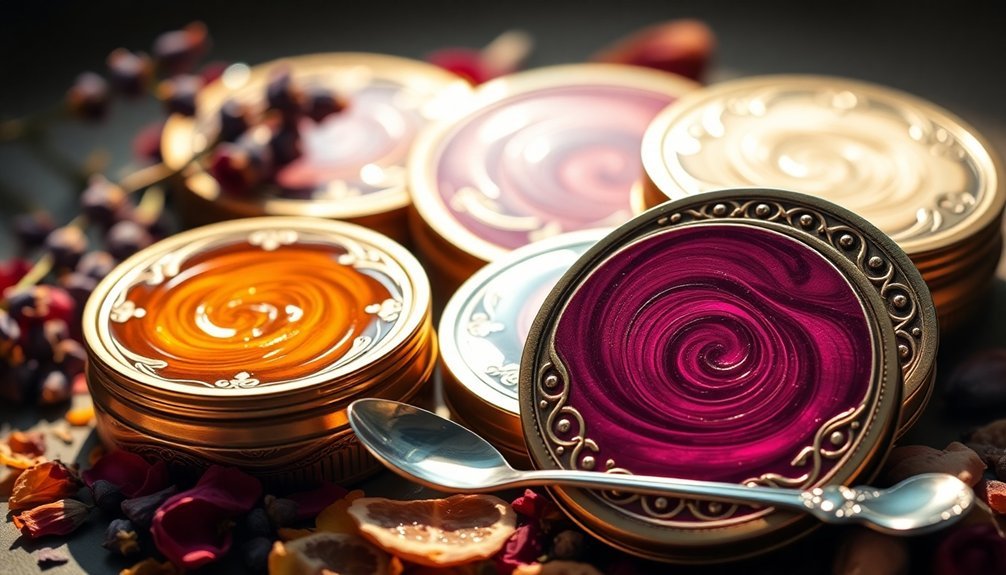
To get the most from your solid perfume, warm it slightly with your fingertips before applying to your pulse points, including wrists, neck, and behind the ears.
You'll enhance the fragrance's staying power by gently massaging the perfume into moisturized skin at these key areas.
For an even more intense and long-lasting scent, try layering your solid perfume over matching body lotion or cream.
Pulse Point Application Strategy
When applying oil-based solid perfumes, strategic placement on pulse points maximizes their fragrance impact throughout the day. Your body's natural heat helps release the scent gradually, creating a lasting impression.
For best results, warm the perfume slightly with your fingertips before application, as this helps it blend seamlessly with your skin's natural oils.
Key pulse points for ideal fragrance diffusion:
- Behind your ears and neck area for a subtle scent that lingers near your face
- Inside of elbows and wrists where blood vessels run close to the skin
- Center of your chest, especially when wearing open-neck clothing
- Behind your knees for an unexpected touch of fragrance
Remember to apply sparingly, as solid perfumes are highly concentrated and a little goes a long way.
Layering for Lasting Scent
Building upon effective pulse point application, mastering the art of fragrance layering can transform your solid perfume experience into a complex, long-lasting journey. Start by applying your base notes first, allowing them to settle before adding middle and top notes. You'll want to use a light touch with each layer, ensuring no single scent overpowers the others.
| Layer Type | Application Timing | Key Benefit |
|---|---|---|
| Base Notes | First/Morning | Longevity anchor |
| Middle Notes | 2-3 minutes after | Depth/complexity |
| Top Notes | Final layer | Immediate impact |
For best results, moisturize your skin before layering, and use a cotton swab for precise application. Remember to test your combinations on paper first, and keep track of successful blends in your perfume journal. This systematic approach will help you create signature scents that evolve beautifully throughout the day.
Warming Before Applying
Proper warming techniques can dramatically enhance your solid perfume's performance and staying power. Before application, warm the product with your fingertips to soften its consistency and guarantee even distribution on your skin.
For best results, apply to moisturized skin, focusing on pulse points where your body heat will naturally release the fragrance throughout the day.
- Gently press your fingertip against the solid perfume until it begins to soften
- Apply to key pulse points like wrists and neck for ideal scent diffusion
- Use on well-moisturized skin to lock in the fragrance longer
- Store your solid perfume in a cool, dark place between uses to preserve its integrity
Remember that solid perfumes typically offer a more subtle scent profile, so you might need to reapply more frequently than with liquid fragrances.
Frequently Asked Questions
How Do I Remove Solid Perfume Stains From Clothing?
Blot the stain immediately, then apply liquid dish soap directly. You'll want to dab with rubbing alcohol or white vinegar, and don't dry until the stain's gone. For set-in stains, pre-soak in detergent.
Can I Reheat and Remold My Solid Perfume if I Don't Like the Shape?
Yes, you can safely reheat and remold your solid perfume using a double boiler or microwave on low heat. Just make sure it's completely cooled before handling, and store it properly afterward to maintain quality.
Why Does My Solid Perfume Develop a Grainy Texture Over Time?
Your solid perfume's grainy texture is likely due to temperature fluctuations and ingredient separation. The way you store it matters – when it's exposed to varying temperatures, the oils and waxes can crystallize.
Is It Possible to Convert My Favorite Liquid Perfume Into Solid Form?
Yes, you can convert your liquid perfume into solid form by mixing it with beeswax and a carrier oil. The process requires careful heating and blending to maintain the fragrance's integrity.
How Can I Prevent My Solid Perfume From Melting During Summer Travel?
Store your solid perfume in a cool container, avoid direct sunlight, and keep it in an insulated makeup bag. You can also use a mini cooler or store it with cold packs during travel.

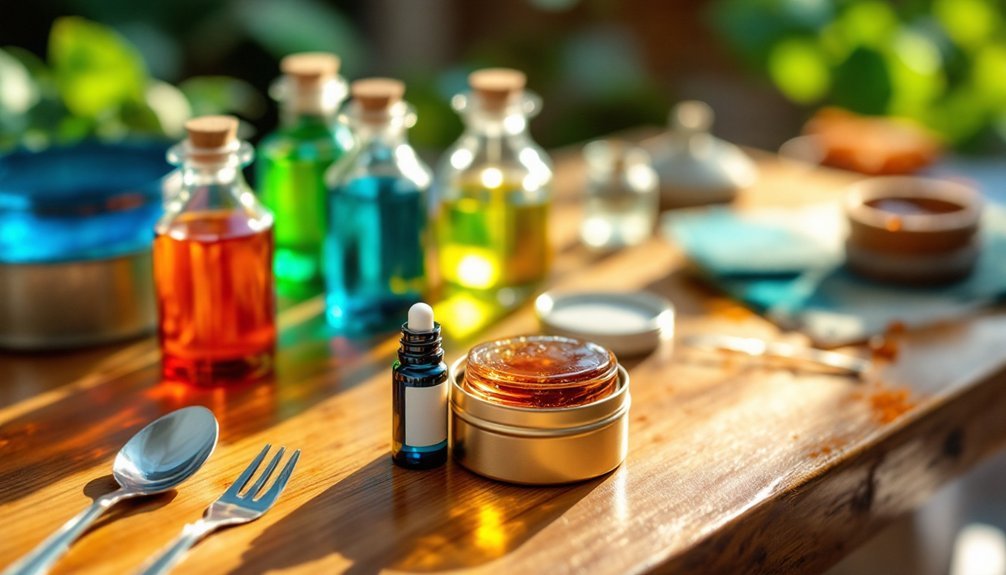



Leave a Reply